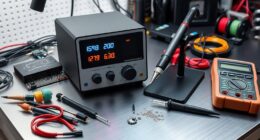Essential PAPRs are essential for your safety, offering reliable protection against airborne contaminants. With continuous airflow and HEPA filtration, they filter out at least 99.97% of harmful particles, keeping you safe in various environments like healthcare or construction. Models vary in price and features, guaranteeing a fit for different needs and budgets. It's important to maintain them well, inspecting filters and replacing batteries regularly to guarantee peak performance. By understanding the right PAPR for your situation, you can enhance your safety. Discover more about selecting, using, and maintaining your PAPR effectively to maximize protection in your work environment.
Key Takeaways
- PAPRs provide continuous airflow and HEPA filtration, capturing 99.97% of airborne particles for enhanced safety.
- Models like Gentex PureFlo and 3M TR-300N+ ensure reliable protection and ease of use.
- Regular maintenance, including filter inspections and battery replacements, is crucial for optimal PAPR performance.
- Selecting the right PAPR involves considering airflow rates, weight, and comfort for extended wear.
- Common applications include woodworking, painting, and healthcare, ensuring safety in environments with airborne contaminants.
Understanding PAPR Technologies

When working in hazardous environments, understanding PAPR technologies is essential for your safety and comfort.
Powered Air-Purifying Respirators (PAPRs) provide continuous airflow and HEPA filtration, ensuring you breathe clean air while minimizing exposure to harmful particles. These battery-operated systems draw ambient air through HEPA filters, achieving airflow rates between 180 and 300 liters per minute, which helps reduce heat stress during long shifts.
You'll find adjustable headpieces, face shields, and hoods that fit securely, allowing compatibility with other personal protective equipment (PPE).
By complying with safety standards like NIOSH and EN, PAPRs guarantee reliable respiratory protection, making it vital for you to choose the right model for your specific working conditions.
Your health and safety depend on it.
Top PAPR Brands and Models

Choosing the right PAPR can greatly impact your safety and comfort in hazardous environments. Some top brands to evaluate include Gentex, 3M, CleanSpace, and RPB.
For instance, the Gentex PureFlo PF3000, priced at $1,348.11, boasts enhanced visibility with a visor. If you're looking for easy maintenance, check out the 3M TR-300N+ Plus ECK Kit at $1,216.99.
The CleanSpace Ultra PAF-1070 offers versatile sizes and costs around $1,485.99, while the RPB T200 with PX5 starts at $1,567.75, providing excellent face seal comfort.
Weighing your options is essential, as PAPR prices range from approximately $1,310.73 to $2,930.81, depending on features and applications.
Make your choice wisely to guarantee ideal protection.
Importance of Safety Standards

Safety standards are fundamental in guaranteeing the effectiveness and reliability of Powered Air-Purifying Respirators (PAPRs). By adhering to regulations like NIOSH and EN, you confirm that your PAPR filters at least 99.97% of airborne particles, considerably reducing health risks.
Compliance involves not just the equipment but also regular maintenance and proper user training, which are essential for best performance. Knowing these standards means you're equipped to make informed decisions about your safety.
It's important to understand the filtration efficiency and breathing resistance requirements to guarantee you're protected in hazardous environments. Remember, your safety hinges on the reliability of your PAPR, so prioritize compliance to protect your health effectively.
Key Accessories for PAPRs

To maximize the effectiveness of your Powered Air-Purifying Respirator (PAPR), investing in key accessories is crucial.
Start with a CA40 Headpiece and Grinding Shield, designed for tailored protection in various environments, priced at $360. You'll also want the 3M TR-838 Battery Tool, which costs around $13.20, making battery attachment efficient and hassle-free.
Other accessories, like face shields and hoods, guarantee a secure fit and compatibility with your existing personal protective equipment.
Additionally, consider spare filters and battery packs to maintain peak performance during extended use.
Maintenance Best Practices

Investing in the right accessories enhances your PAPR's performance, but maintaining it properly is just as important for guaranteeing its longevity and effectiveness. Regular maintenance checks will keep your PAPR functioning efficiently. Here are some best practices to follow:
| Maintenance Task | Frequency |
|---|---|
| Inspect filters | Every use |
| Clean components | Weekly |
| Replace batteries | Every 6 months |
Always keep spare filters and batteries on hand to minimize downtime. Verify your PAPR fits snugly and check for any wear on straps or seals. By following these maintenance best practices, you can extend the life of your PAPR and assure it provides the finest protection when you need it most.
Selecting the Right PAPR

Choosing the right PAPR is vital for guaranteeing ideal protection in hazardous environments. Start by considering the airflow rate, which typically ranges from 180 to 300 liters per minute. This guarantees you have enough fresh air while minimizing heat stress.
Next, think about weight; lightweight models around 2 kg are easier to wear for extended periods. Adjustable fit options are vital for effective sealing, so check for headpieces and hoods that offer a secure fit.
Don't forget to evaluate battery life; lithium-ion batteries with a 59-hour runtime are a great choice. Finally, balance comfort and cost to find a PAPR that meets your specific needs while providing reliable protection.
Your safety depends on making the right choice.
Common Applications for PAPRs

Many industries rely on PAPRs for effective respiratory protection in various hazardous environments.
You'll find them vital in woodworking, where dust and fumes can pose serious health risks. In painting applications, PAPRs protect against harmful vapors and particles, ensuring your safety while working with hazardous materials.
They're also essential in healthcare settings, particularly during procedures that generate aerosols, providing a barrier against infectious agents.
Additionally, construction and demolition sites benefit from PAPRs, as they filter out harmful dust and debris.
Wherever there's a risk of airborne contaminants, PAPRs serve as a reliable shield, allowing you to focus on your tasks with confidence in your respiratory protection.
Frequently Asked Questions
How Long Do PAPR Filters Typically Last Before Needing Replacement?
PAPR filters typically last between 3 to 5 years, depending on usage and environmental conditions. It's essential to monitor their performance regularly and replace them when you notice reduced airflow or increased resistance.
Can PAPRS Be Used in Confined Spaces?
In confined spaces, you'll face both safety and danger. PAPRs can be used effectively, providing essential airflow and filtration. Just verify you comply with safety standards, making sure you're protected while maneuvering those tight environments.
Are PAPRS Suitable for Chemical Exposure?
Yes, PAPRs are suitable for chemical exposure. They provide effective filtration and airflow, ensuring you breathe clean air while working with hazardous substances. Always choose a model compliant with safety standards for ideal protection. Furthermore, PAPRs are designed to provide a high level of protection against chemical exposure, making them an essential part of any personal protective equipment arsenal. When working with hazardous chemicals, it is crucial to have the right equipment, including PAPRs, to ensure the safety of workers. Implementing proper chemical defense techniques, along with using PAPRs, can significantly reduce the risk of exposure and potential harm to individuals working in these environments.
What Is the Average Weight of a PAPR System?
When you're choosing a PAPR, remember—like a feather on the breeze—most systems weigh around 2 kilograms. This lightweight design helps you stay comfortable while ensuring effective protection in hazardous environments.
How Do I Clean and Maintain My PAPR Headpiece?
To clean and maintain your PAPR headpiece, regularly wipe it down with mild soap and water, ensuring you remove all contaminants. Check for wear and tear, replacing any damaged parts promptly for ideal performance.
Conclusion
In a world where hazardous particles lurk like invisible ninjas, a PAPR is your superhero cape, shielding you from danger with a powerful gust of purified air! Imagine striding confidently through toxic clouds, knowing your trusty respirator's got your back. With the right PAPR, you're not just safe; you're invincible! So gear up, embrace the power of protection, and let your PAPR be the magic barrier between you and the perils that threaten your health!










